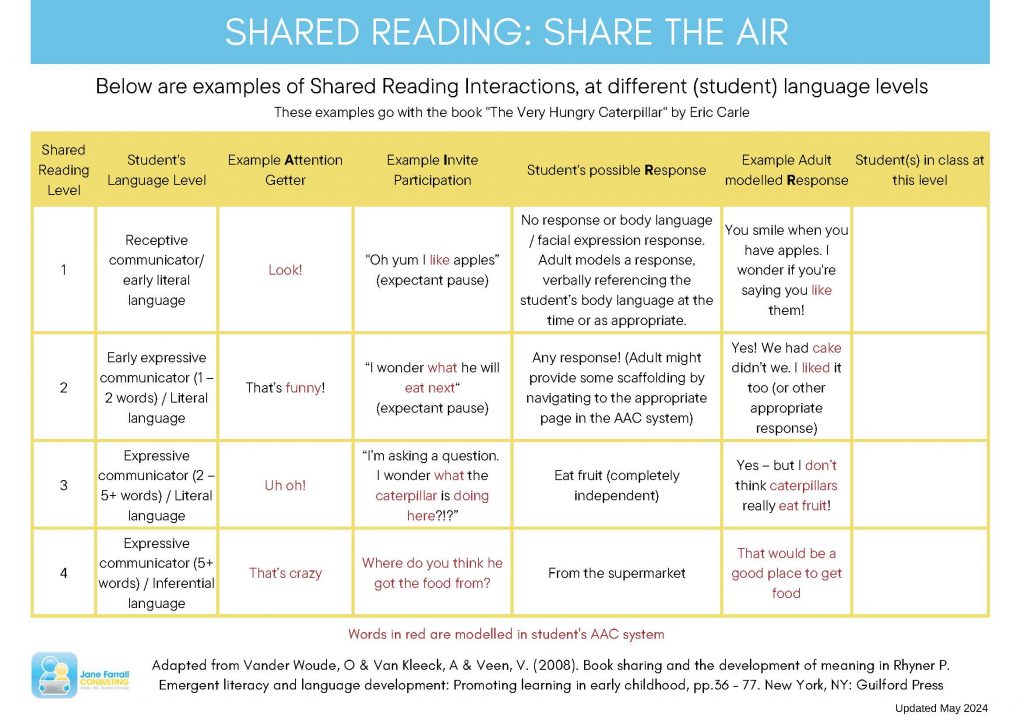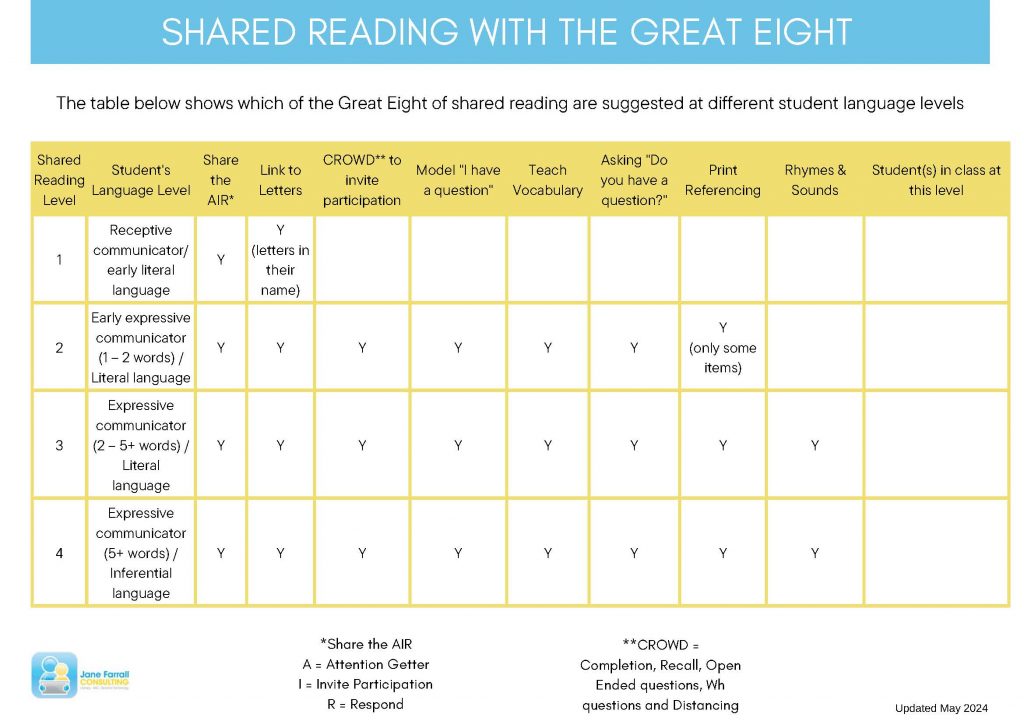Shared Reading
Shared reading is the interactive reading of a book between student(s) and an adult.
We start reading with babies almost as soon as they are born – This helps them learn joint attention, provides exposure to a much wider range of vocabulary than we use in day to day communication, helps them to learn about language – and a whole heap of other skills, including how books work! For these reasons and many more, all emergent students will benefit greatly from shared reading. Many transitional and conventional literacy learners also benefit, and enjoy, having great books read to them.
If you have emergent students in your classroom, you should have a shared reading book of the week. If you have students with complex communication needs you would also use AAC in the shared reading interactions that you have each day. You would also do shared reading with your students in the independent reading block – but the difference here is that they get to pick the book! Click here for a blog post which includes some videos that could be helpful. Remember: using AAC throughout shared reading is really important for your students with complex communication needs to build their understanding of language and using AAC.
Shared Reading Presentation
In 2020, I was honoured to be asked to do the Keynote presentation at the AAC in the Cloud virtual AAC Conference. The presentation was titled “Shared Reading: Let’s Be Interactive” and you can view the presentation below.
Shared Reading Levels
The research into shared reading, shows us that adults change their language and the activities they do during shared reading, based on the language level of the individual they are reading with. There are four different language levels that have been identified. The table below shows these four different levels.

(Share the AIR table Updated May 2024)
Use the description of the student’s language level to pick their shared reading level.
With all students we use AIR – we get their Attention, then we Invite participation and then they Respond (or we model a response for a receptive communicator) (Farrall, 2019). AIR is very similar to CAR (Notari, Syverson, Maddox, and Cole, 1999).
Shared Reading Level 1: For these students, AIR focuses on like/dislike invitations OR we simply comment or give our opinion and then use an expectant pause to see what happens. These students are often receptive communicators, and we use their facial expression, body language, vocalisations and any other cues that we can, to attribute meaning as their response. If there is nothing we can attribute meaning to, then we model a response. It’s important to remember that we aren’t expecting an actual yes or no response from them or for them to use AAC on demand.
Shared Reading Level 2: For a student at the second level, AIR moves to more open ended invitations to participate. These questions don’t have a definite right or wrong answer and have a focus on the student being successful at participating e.g. what do you think he’ll eat next?
Shared Reading Level 3: For a student at the third level, the questions can be open ended or have a definite answer. At this point we are starting to give the student feedback about their answers and are expecting an answer on topic. The questions should be based on information from the book e.g. How do you think the caterpillar is feeling now?
Shared Reading Level 4: For a student at the fourth level, the questions can move to being inferential, This means that we can ask questions that they need to use their world knowledge to answer, rather than questions which only use the information in the book e.g. where would the caterpillar find that food? Students at this level are also usually ready for comprehension instruction, and this should take priority over shared reading if you have limited time.
AIR is just one of the activities that adults naturally build into shared reading. Some other activities are covered below – and I call them The Great Eight. Just like AIR, these are implemented based on the shared reading level of the student.

(The Great Eight poster updated August 2022)
The table below shows which of the Great Eight we should use with students at different levels of shared reading.

(Share the AIR table Updated May 2024)
Shared Reading Resources to download
For a range of resources to help you to implement AIR and the Great Eight in your classroom, download the handouts below. And please remember that Shared Reading can happen in a small group or 1:1 – so we often end up doing it with the whole class (with a book of the week) and again with students as a 1:1 activity through the day (with books they select).
Shared Reading General Resources
- Shared Reading: Let’s Be Interactive handout from AAC in the Cloud presentation
- Language Levels Tables (shown above and updated May 2024)
- Great Eight Poster (shown above and updated August 2022)
- Share the AIR poster (for students at Level 1 created February 2020)
- Shared Reading record forms
Blog Posts from Jane Farrall Consulting related to Shared Reading:
- Somebody’s Land: Shared Reading
- Shared Reading: Book Week 2021
- Book Tips for Older Readers
- Zombies and Independent Reading
- Shared Reading – Keep the Interaction Going
- Reading at Home
Other Resources
For information about books, texts and curating books, see the Independent Reading section.
Tar Heel Shared Reader

